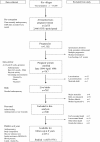Vitamin B12 and folate concentrations during pregnancy and insulin resistance in the offspring: the Pune Maternal Nutrition Study
- PMID: 17851649
- PMCID: PMC2100429
- DOI: 10.1007/s00125-007-0793-y
Vitamin B12 and folate concentrations during pregnancy and insulin resistance in the offspring: the Pune Maternal Nutrition Study
Abstract
Aims/hypothesis: Raised maternal plasma total homocysteine (tHcy) concentrations predict small size at birth, which is a risk factor for type 2 diabetes mellitus. We studied the association between maternal vitamin B12, folate and tHcy status during pregnancy, and offspring adiposity and insulin resistance at 6 years.
Methods: In the Pune Maternal Nutrition Study we studied 700 consecutive eligible pregnant women in six villages. We measured maternal nutritional intake and circulating concentrations of folate, vitamin B12, tHcy and methylmalonic acid (MMA) at 18 and 28 weeks of gestation. These were correlated with offspring anthropometry, body composition (dual-energy X-ray absorptiometry scan) and insulin resistance (homeostatic model assessment of insulin resistance [HOMA-R]) at 6 years.
Results: Two-thirds of mothers had low vitamin B12 (<150 pmol/l), 90% had high MMA (>0.26 micromol/l) and 30% had raised tHcy concentrations (>10 micromol/l); only one had a low erythrocyte folate concentration. Although short and thin (BMI), the 6-year-old children were relatively adipose compared with the UK standards (skinfold thicknesses). Higher maternal erythrocyte folate concentrations at 28 weeks predicted higher offspring adiposity and higher HOMA-R (both p < 0.01). Low maternal vitamin B12 (18 weeks; p = 0.03) predicted higher HOMA-R in the children. The offspring of mothers with a combination of high folate and low vitamin B12 concentrations were the most insulin resistant.
Conclusions/interpretation: Low maternal vitamin B12 and high folate status may contribute to the epidemic of adiposity and type 2 diabetes in India.
Figures



Comment in
-
Metabolic programming of offspring by vitamin B12/folate imbalance during pregnancy.Diabetologia. 2008 Jan;51(1):6-7. doi: 10.1007/s00125-007-0869-8. Diabetologia. 2008. PMID: 18034225 No abstract available.
References
-
- {'text': '', 'ref_index': 1, 'ids': [{'type': 'DOI', 'value': '10.1007/BF00400248', 'is_inner': False, 'url': 'https://doi.org/10.1007/bf00400248'}, {'type': 'PubMed', 'value': '1644236', 'is_inner': True, 'url': 'https://pubmed.ncbi.nlm.nih.gov/1644236/'}]}
- Hales CN, Barker DJP (1992) Type 2 (non-insulin dependent) diabetes mellitus: the thrifty phenotype hypothesis. Diabetologia 35:595–601 - PubMed
-
- The International Diabetes Federation diabetes atlas. Available at www.eatlas.idf.org, accessed 4 March 2007
-
- Gopalan C (1994) Low birthweight: significance and implications. In: Sachdev HPS, Chaudhary P (eds) Nutrition in children: developing country concerns. Imprint, New Delhi
-
- {'text': '', 'ref_index': 1, 'ids': [{'type': 'DOI', 'value': '10.2337/diabetes.48.12.2422', 'is_inner': False, 'url': 'https://doi.org/10.2337/diabetes.48.12.2422'}, {'type': 'PubMed', 'value': '10580432', 'is_inner': True, 'url': 'https://pubmed.ncbi.nlm.nih.gov/10580432/'}]}
- Bavdekar A, Yajnik CS, Fall CHD et al (1999) Insulin resistance in 8 year old Indian children, small at birth, big at 8 years, or both? Diabetes 48:2422–2429 - PubMed
-
- {'text': '', 'ref_index': 1, 'ids': [{'type': 'DOI', 'value': '10.1210/jc.2002-020434', 'is_inner': False, 'url': 'https://doi.org/10.1210/jc.2002-020434'}, {'type': 'PubMed', 'value': '12466355', 'is_inner': True, 'url': 'https://pubmed.ncbi.nlm.nih.gov/12466355/'}]}
- Yajnik CS, Lubree HG, Rege SS et al (2002) Adiposity and hyperinsulinemia in Indians are present at birth. J Clin Endocrinol Metab 87:5575–5580 - PubMed
Publication types
MeSH terms
Substances
Grants and funding
LinkOut - more resources
Full Text Sources
Other Literature Sources
Medical

